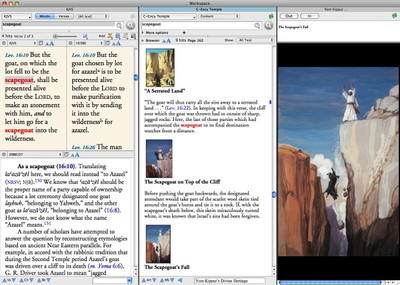We all know what a “scapegoat” is: it’s someone who takes the blame—willingly or not—for someone else’s wrongdoing. Yet few people realize that the term “scapegoat” comes from the Bible. Search the King James Bible for scapegoat and you’ll find the following practice described in Leviticus 16:
And Aaron shall cast lots upon the two goats; one lot for the LORD, and the other lot for the scapegoat. And Aaron shall bring the goat upon which the LORD’S lot fell, and offer him for a sin offering. But the goat, on which the lot fell to be the scapegoat, shall be presented alive before the LORD, to make an atonement with him, and to let him go for a scapegoat into the wilderness. —Lev 16:8–10, KJV
What’s going on here? What exactly is the role of this goat sent out to the wilderness? It sounds a little like the “scapegoat” was the more fortunate of the two goats, since it merely got released into the wild while its counterpart got sacrificed.
The situation becomes even more intriguing when you see that many newer translations no longer use the term “scapegoat.” Instead, they speak of this goat as being “for Azazel.” And here I thought newer translations were supposed to be easier to understand!
Background resources like the Zondervan Illustrated Bible Background Commentary on the Old Testament (ZIBBCOT) and some of the Carta books on Jerusalem and the Temple explain and illustrate ancient rituals like this one in far more detail than you get with most standard commentaries.
For example, if you open ZIBBCOT in parallel with the Leviticus passage, you’ll learn about other Ancient Near Eastern rituals in which sins are transferred to a substitute which is then sent away. You’ll also read that the term “Azazel” is probably a proper name of some sort rather than a description of the goat’s function.
Another way to find out more about the scapegoat is to select the word “scapegoat” or “azazel” (depending on the translation) and then amplify to a resource like Carta’s Illustrated Encyclopedia of the Holy Temple in Jerusalem. This incredible resource includes artistic depictions of the tabernacle and temple throughout history. It also chronicles how Jewish festivals such as Yom Kippur were performed in painstaking detail. This includes the scapegoat ceremony, each stage of which is carefully described and vividly illustrated. You’ll see the priest laying hands on the scapegoat and confessing Israel’s sins over it. You’ll see the scapegoat being led out of the city of Jerusalem and into the wilderness. And you’ll see the scapegoat being pushed off a cliff to its doom!
Clearly, the scapegoat didn’t get off any easier than its counterpart who was offered as a sin offering. Then again, that shouldn’t come as that much of a surprise. After all, the one who escapes punishment by means of a scapegoat is not the scapegoat himself, but the one whose wrongdoing gets blamed on the scapegoat.
This is just one example of how the background commentaries from Zondervan and the richly illustrated books from Carta can make the more obscure passages of the Bible absolutely come to life. If you were preaching a sermon about the scapegoat, the sequence of illustrations from the Encyclopedia of the Temple would make for a great Keynote presentation. And if you wanted to draw parallels between the scapegoat ceremony and the crucifixion of Jesus, you could finish your Keynote with images of Jesus carrying his cross and being crucified outside the city walls. Even if you don’t typically utilize visuals in your teaching, you’ll be better equipped to describe those aspects of the ceremony which you have now seen illustrated.
Remember, we’re currently offering an introductory special on ZEB, ZIBBCOT, and ZIBBCNT until November 15. You can also save money on the Carta books by buying the bundle best suited to your needs.


